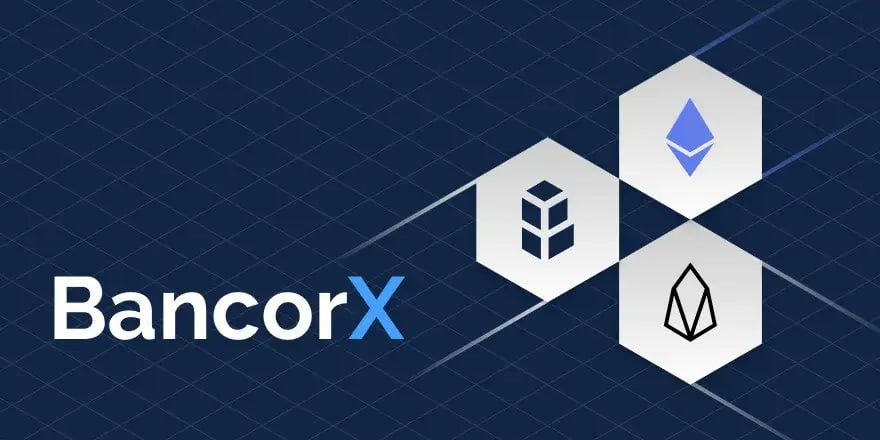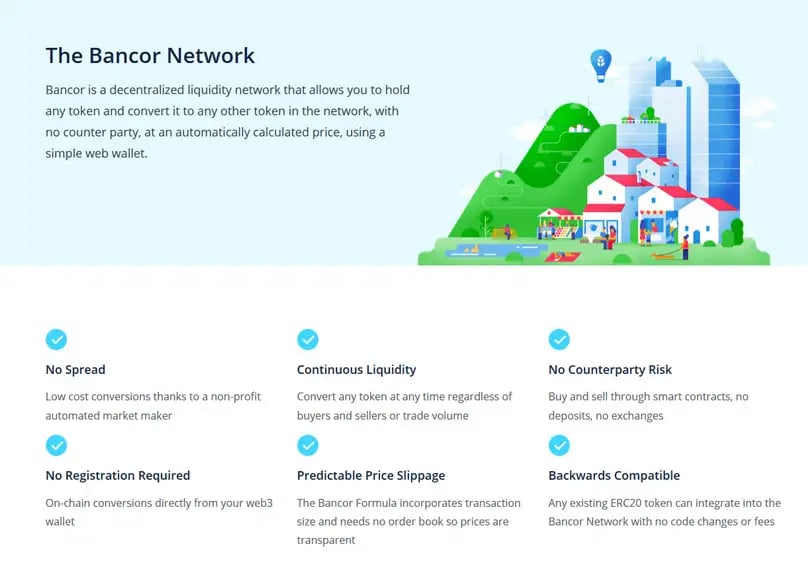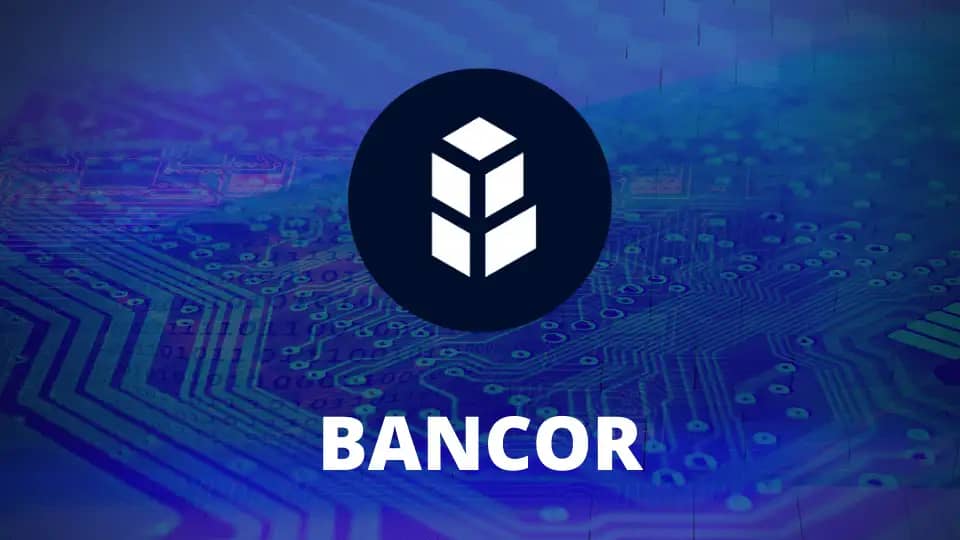Subscribe to wiki
Share wiki
Bookmark
Bancor
The Agent Tokenization Platform (ATP):Build autonomous agents with the Agent Development Kit (ADK)
Bancor
Bancor (BNT) is an on-chain liquidity protocol and decentralized exchange (DEX) on the Ethereum and EOS blockchains as well as a cryptocurrency[1][8].

On July 31, 2020, Bancor shipped its V2 upgrade with several new features including single-token exposure (100% exposure to a single asset), impermanent loss mitigation , and 20X liquidity amplification.
In August 2020, ParaFi Capital, a DeFi-focused investment firm, invested in the Bancor Network Token, BNT. This strategic investment aims to further Bancor’s mission of enabling global, permissionless on-chain liquidity[7][15].
Overview
The Bancor Protocol is made up of a network of smart contracts called “liquidity pools” designed to perform algorithmic token trades and pooling of on-chain liquidity[16].
What sets Bancor apart from most decentralized and centralized exchanges is liquidity on Bancor is provided by thousands of unaffiliated users who each receive a share of Bancor’s trading fees, instead of liquidity coming from a small handful of professional market-makers. This is because adding liquidity on Bancor is permissionless (no central party can block or control the process) and easy for everyday users (add liquidity and earn fees in a couple of clicks).
In August 2020, ParaFi Capital, a DeFi-focused investment firm, invested in the Bancor Network Token, BNT. This strategic investment aims to further Bancor’s mission of enabling global, permissionless on-chain liquidity.
Bancor Network Token (BNT)

Every liquidity pool on Bancor holds BNT (Bancor’s Network Token) in its reserves as well as the “base token” receiving liquidity. BNT serves as the intermediary token connecting pools in the network and across blockchains[21].
Users who trade on Bancor do not need to hold BNT; however, users creating a liquidity pool on Bancor or providing liquidity to an existing pool must hold BNT.
In mid-December 2020, the price of BNT increased by 86% in merely two days from $1.02 to $1.919 as a result of Coinbase listing BNT and the growing volume of Bancor’s DEX.
ETHBNT Token
ETHBNT is a Bancor pool token representing shares in the ETH:BNT liquidity pool. ETHBNT collects fees from ETH-based conversions on Bancor. On January 1st, 2020, the ETHBNT token was airdropped on all users holding BNT. Tracking and swapping all Bancor tokens and pool tokens can be done on Bancor-integrated front-ends, such as 1inch. exchange, ParaSwap, and Zerion.
Initial Coin Offering
On June 12th, 2017, Bancor raised $153 million worth of Ether by selling its digital tokens for three hours. At the time, this was the largest token sale until the Tezos ICO.
Bancor Liquidity Pools
Liquidity pools perform autonomous, peer-to-contract token trades and generate fees from each trade. Users can collect a share of a pool’s trading fees by adding liquidity to a pool and holding its “pool token”. Pool tokens are ERC20 tokens that represent ownership stakes in liquidity pools. When a user adds liquidity to a Bancor pool, they receive pool tokens in proportion to the number of assets they have added to the pool.
Bancor pool tokens can accrue value in three ways:
- trading fees generated by the pool ;
- pool rewards provided by a token project (via “liquidity provider incentive programs”) ;
- pool rewards provided by the Bancor Protocol (via BNT inflation)
There are now numerous interfaces where a user can add and remove liquidity from Bancor pools, track profits and analyze the best-performing pools on the network. Examples include DeFi platforms like Zerion, 1inch. exchange, ParaSwap, CoTrader, and EOS Nation.
Liquid Token
A Liquid Token is a new type of cryptocurrency invented by Bancor. Liquid Tokens are built on smart contracts with "connectors" to another group of tokens. This allows them to be bought and sold for any tokens to which they are connected, at continuously calculated prices according to the Bancor Formula. The Bancor Formula maintains a constant ratio between a Liquid Token’s value and the value of the tokens it is connected to, adjusting prices to balance buy and sell volumes in real-time. Liquid Tokens can be converted without needing to match two parties, eliminating counterparty risk and decoupling liquidity from trade volume and exchange listings.
Bancor V2
On July 31, 2020, Bancor shipped its V2 upgrade starting with capped liquidity for select token pairs. Bancor v2 was launched with several pools: Aave (LEND), ChainLink (LINK), Enjin Coin (ENJ), Ren, and Kyber Network Crystal (KNC)[19][22].
The upgrade included several new features including single-token exposure (100% exposure to a single asset) , impermanent loss mitigation , and 20X liquidity amplification.
Bancor v2 entered a beta release period and during this time, pools can be deployed with temporary limits on the amount of liquidity that can be deposited. Once a pool’s liquidity cap is reached, no more liquidity providers can join the pool until the cap is removed. After the cap is removed by a pool manager, it can never be reactivated in the given pool.
Pools can be set with liquidity caps of up to $500K per reserve (or $1M total per pool). Since Bancor v2 pools are equipped with 20X liquidity amplification, a pool with $1M in reserves acts like a $20M pool in terms of slippage on token swaps.
Bancor v2.1
In November 2020, Bancor v2.1 was launched. Bancor v2.1 is a single-sided AMM providing liquidity pools, equipped with impermanent loss insurance. The new version of Bancor uses an elastic supply token (BNT) to manage liquidity across the network. BNT is continuously co-invested and burned by the protocol to support single-sided contributions and to provide impermanent loss insurance for liquidity providers.
Following the launch of Bancor v2.1 and the announcement of BNT liquidity mining, Total Value Locked (TVL) increased 5X from $15 million to over $85 million, driving a 300% increase in weekly swap fees generated by the protocol.
BNT Liquidity Mining
On November 16, 2020, the Bancor team announced a new community proposal aimed at kickstarting a liquidity mining program that drives new liquidity to the Bancor pools. The proposal involves incentivizing 8 token pools in the first round of BNT liquidity mining including the following:
- Large-Caps: ETH, Wrapped Bitcoin (WBTC), Tether (USDT), USD Coin, DAI, LINK
- Mid-Caps: OCEAN and renBTC
The large-cap pools will receive 100,000 – 200,000 BNT per week whereas the mid-cap pools will receive 10,000 – 20,000 BNT per week. Initial estimates provided by the Bancor team hint that yields will range between lows of 20% APY and all the way up to 3000% APY based on the amount of liquidity provided by users per pool. The proposed scheme will also allow two new token pools to be incentivized and each time a new token pool is added, it will receive BNT rewards for 12 consecutive weeks by default. These new pools must be voted in by Bancor governance and the same pool can be incentivized multiple times.
Some saw Bancor's liquidity mining strategy as a vampire attack against Uniswap since it was launched on the day UNI rewards dried up. Initially, the APY was around 300%. On the day of launch, Bancor had $24 million dollars in Total Value Locked (TVL) and in only a few days it climbed to more than $62 million dollars locked in the protocol"[4][5][19].
See something wrong?
The Agent Tokenization Platform (ATP):Build autonomous agents with the Agent Development Kit (ADK)
